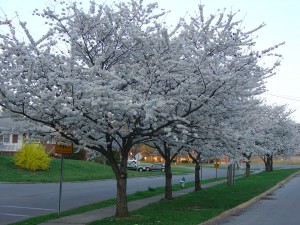In The Southeast U.S. most ornamental flowering cherry trees (Prunus spp.) are challenged by summer heat and humidity. ‘Yoshino Cherry’ (Prunus x yedoensis) continues to be the top performer in the group (USDA hardiness zones 5-8).
In 1912, the Japanese government gifted the United States 3000 Yoshino flowering cherries. In the years that followed, Yoshino became the premier flowering cherry at spring festivals in Washington, DC, Macon, Georgia, and other locales.
Yoshino is native to Japan, Korea and China. The beautiful blossoms cover every twig on the tree. The white to pink flowers are slightly fragrant. The trees flower dependably every spring although late winter freezes may damage some flower buds.
A mature Yoshino reaches 20 feet tall and 15 feet wide. Its compact form makes it a good fit on small residential spaces along with other spring beauties such as crabapples, azaleas, forsythias, and others.
Yoshino should be planted in moist well-drained soil and in full day sun. Properly mulch a young Yoshino until tree becomes well established. Insect borers and stem canker diseases can be serious problems. Growth rate is rapid and disease pressure less when properly sited. Annual pruning within a month after bloom is recommended to remove root suckers, broken branches, and diseased wood.
Several cultivars of Yoshino cherry are available at garden centers exhibiting slightly different traits:
‘Akebono’ (aka ‘Daybreak’) – soft pink double flowers
Cascade Snow™ – snow white flowers, dark green summer foliage turns yellow-orange in fall; highly disease resistant
‘Ivensii’ – fragrant white flowers on weeping branches
‘Pink Shell’ – flower buds open pink and fade to white
‘Yoshino Pink’ – later blooming pink cultivar


 Posted in
Posted in 
